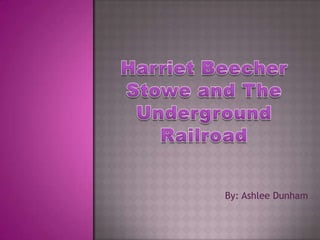
Harriet Powerpoint
- 2. Harriet Beecher Stowe was an American author and abolitionist in the years prior to the American Civil War.
- 3. Harriet Elisabeth Beecher was born in Litchfield, Connecticut on June 14, 1811. She is youngest daughter of Lyman and Roxanna. She has 8 siblings. Her mother passed away when she was only 4 years old. Her father was a Congregational minister. Harriet took after her mother. She was very interested in improving her education, so Harriet pursued the same goal.
- 4. Picture of the Beecher family c.1850. Taken by Mathew Brady, New York. Standing from the left : Thomas, William. Edward, Charles, Henry. Seated from the left: Isabella, Catherine, Lyman, Mary, Harri et. Courtesy of The Harriet Beecher Stowe Center, Hartford, Connecticut.
- 5. Harriet Beecher was not the only one in her family to be active in abolition. Her brother, Henry Ward Beecher (1813-1887), was a noted minister in Brooklyn, New York. Henry was active in the abolitionist movement. Along with abolition; her sister, Catharine Beecher (1800-1878) founded many schools for young women throughout the country and was a prolific author while her youngest sister, Isabella (1822-1907), became active in the women's suffrage movement. Many of her siblings were active reformers.
- 6. At the time Harriet attended Hartford Female Seminary, only a handful of schools took the education of women seriously. Catharine began to introduce many innovations at the school. Her teachings included physical education , home economics, and student government. The women were expected to stay at home. Because of this, women needed very little education. Catharine helped to change these ideas. She argued that running a home was as complicated as running an office and that young women should be instructed in these duties the same way boys should be instructed in careers outside the home. Catharine also stressed the importance of written expression. Her students spent many hours composing essays. As a result of Catharine's teaching methods, Harriet received an unusually fine education, and, under her sister's guidance, began to develop her talent as a writer
- 7. Harriet studied at Hartford Female Seminary. Her oldest sister, Catharine, opened and operated the school. After Stowe graduate from school she became a teacher at the seminary. The Beecher family moved to Cincinnati, Ohio where Lyman Beecher was president of Lane Theological Seminary. Harriet followed her father’s footsteps. It was there at Lane Theological Seminary where she met her husband, Calvin Stowe, a professor at the Seminary.
- 8. Lane Seminary was a school devoted to training Congregational ministers. Lane Seminary schooled only eighteen Ohioans in 1834. The students here at Lane Seminary debated the merits of immediate emancipation. Most of the students agreed that slavery was a sin an abomination and wanted it to end now. With the abolition, many abolitionist began working with blacks in Cincinnati.
- 9. She met Calvin in 1836. It was four years later after marriage, Stowe gave birth to four of their seven children. Six of their seven children were born in Cincinnati.
- 10. Calvin and Harriet had seven children. Pictured here are six of the seven. Their son, Samuel Charles died when he was 1. They were survived by only 3 children. Georgiana May Henry Ellis Twins with Harriet: Eliza and Harriet Frederick William Charles Edward
- 11. Harriet first got ideas about antislavery from her father’s belief in human equality; although a majority derived from her stay in Cincinnati. It was in Cincinnati she witnessed the violence and brutality of slavery while residing briefly in Washington, Kentucky.
- 12. It was during the 1830’s, Stowe became an abolitionist. At that time, slavery was prohibited north of the Ohio River. (This was due to the passage of the Northwest Ordinance of 1787). In the state of Kentucky, slavery was legal. Cincinnati is directly north of Kentucky. Because of this, thousand of runway slaves would pass through Cincinnati as they traveled to freedom along the Underground Railroad. Stowe began to become friends with some Ohio abolitionist. One of her good friends, John Rankin, had a house that served as a stop on the Underground Railroad.
- 13. In 1850, Harriet’s husband, Calvin Stowe took a position at Bowdoin College in Brunswick, Maine. While they were in Maine, Harriet wrote Uncle Tom’s Cabin. Bowdoin College Campus, Harriet and Calvin’s House
- 14. Uncle Tom’s Cabin The stories Harriet heard about the slaves from the Underground Railroad conductors and from the slaves themselves helped her form the basis for her book Uncle Tom’s Cabin. Stowe reacted to the Fugitive Slave Act of 1850. This act made it illegal to assist and escaped slave.
- 15. After Harriet’s book, Uncle Tom’s Cabin, was published, she was invited to visit the British Isles in 1853. When she arrived in the Isles she was greeted enthusiastically. She did not visit Britain just once. She went back and returned in 1856, and again in 1859. In the New York newspaper, The Independent, a large column was published by Harriet. She urged the women in the United States to used their influence against slavery. She urged them to do so by signing petitions, spreading information, and inviting guest speakers to speak to the community about the subject.
- 16. She urges white Northerners to welcome escaped slaves and treat them with respect.
- 18. House in Hartford, Connecticut Nook Farm Neighborhood
- 21. Harriet and her family moved into their home in Hartford Connecticut in 18373. A year later, Samuel Clemens (who we know as Mark Twain, and his family moved into a house just across town. The two families visited each other often. Lived here the last years of her life. She was neighbors of Mark Twain.
- 22. She used her gift of storytelling and writing as a way of bringing about change to American society.
- 23. Harriet Beecher Stowe was one of the most popular American writers of the nineteenth century.